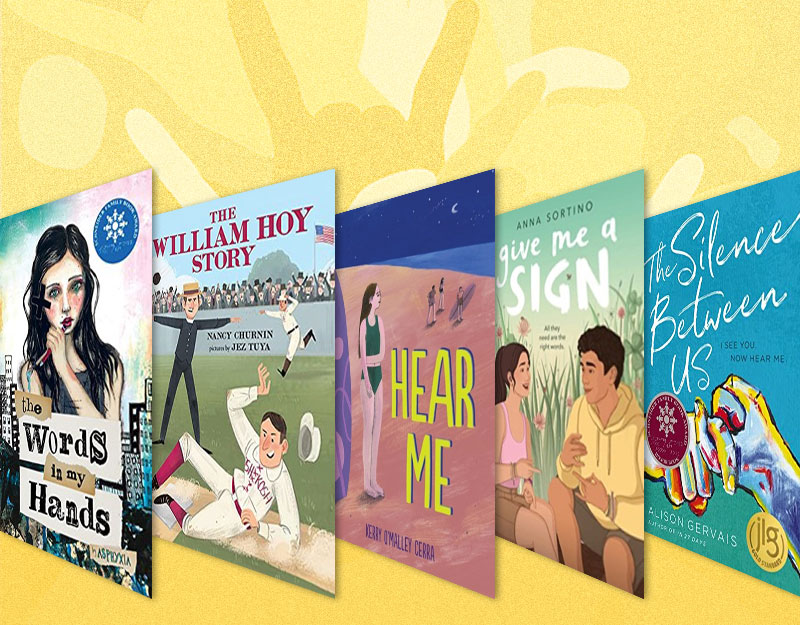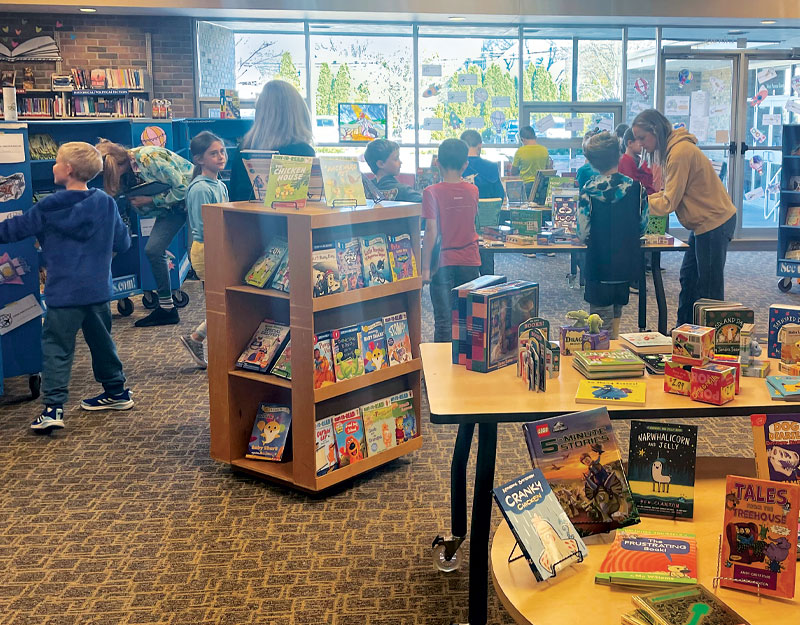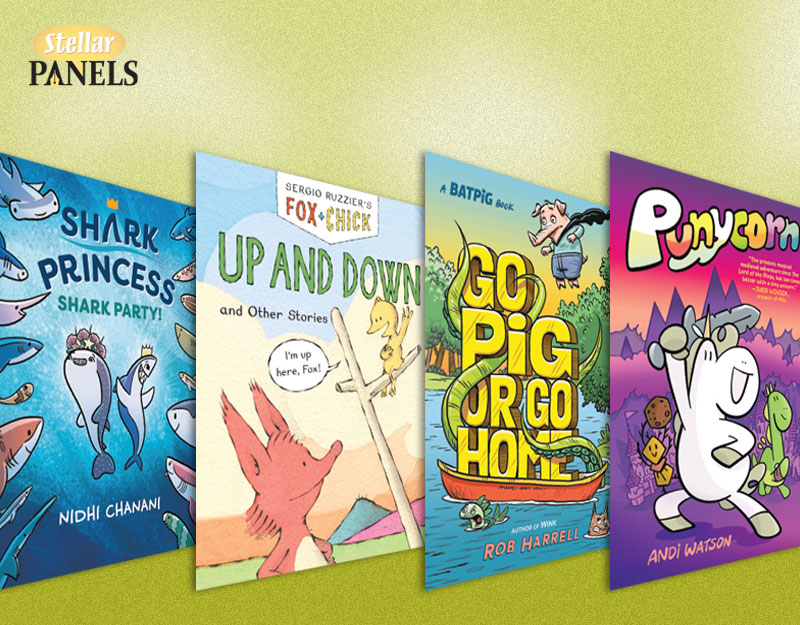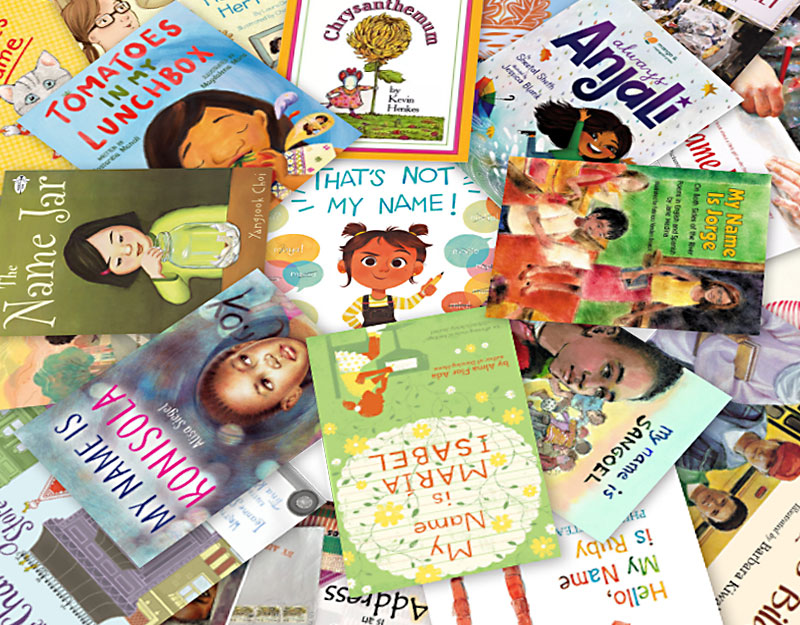Radiant Child: The Story of Young Artist Jean-Michel Basquiat – 2017 Caldecott Medal Winner
Winner of the 2017 Caldecott Award
 Radiant Child: The Story of Young Artist Jean-Michel Basquiat
Radiant Child: The Story of Young Artist Jean-Michel Basquiat
Written and Illustrated by Javaka Steptoe
Published in 2016 by Little Brown
ISBN 978-0-316-21388-2
Grades PreK – Grade 12
Book Review
“Somewhere in Brooklyn, between hearts that thump, double Dutch, and hopscotch and salty mouths that slurp sweet ice, a little boy dreams of being a famous ARTIST.” Javaka Steptoe’s striking picture book biography focuses on the childhood experiences of the iconic artist Jean-Michel Basquiat. Using materials found on the streets of New York City, Steptoe pays tribute to Basquiat’s style with unique and intricate collage work. The text is lyrical, emphasizing Basquiat’s passion for making art, his driving ambition, his traumas (a car accident, the separation of his parents, and his mother’s mental illness) and his triumphs (his rise as a young adult from graffiti artist to gallery sensation). Jean-Michel Basquiat’s story is complex, yet Steptoe offers young readers an accessible introduction to his life and the sociopolitical salience of his art. For younger children, the book offers an opportunity to discuss artistic process, self expression, perceptions of art, and the many roles that art can play. Additionally, the book opens up space to talk about family, mental illness, trauma, healing, and addiction. Students who are ready for more challenging conversations can dig deeper into Basquiat’s story. While the text stays focused on his childhood and his rise to success, the images sometimes invoke the darker aspects of Jean-Michel’s life. For example, a final image depicts Jean-Michel in boxer’s gloves with a triumphant pose, a crown suspended above his head. Behind him, numerous headlines drawn from periodicals appear, including text such as “Nobody Loves a Genius Child” and “Hazards of Sudden Success and Fame.” Basquiat’s death from drug overdose at the age of 27 is mentioned not in the main text, but in an author’s note. Using additional resources, students can extend their understandings of Basquiat’s lived experiences, discussing racism, prejudice, ambition, position, celebrity, and power. With this BEAUTIFUL and captivating book, Steptoe makes a remarkable contribution to classroom conversations about social justice.
Teaching Ideas: Invitations for Your Classroom
Grades K and Up
What is Art? / What is Beautiful to You? Javaka Steptoe offers readers this beautiful definition: “Art is the street games of little children,/ in our style and the words that we speak./ It is how the messy patchwork of the city/ creates new meaning for ordinary things” (unpaged). Invite your students to discuss the question: What is art? Next, invite them to write and draw their responses to this question. Extend the exploration with a broad look at examples of art in different styles and media. Engage older students with critical literacy questions such as: Whose art gets displayed in museums? What is “fine art”? Who decides what is considered “fine art”?
ADVERTISEMENT
ADVERTISEMENT
Place-Based Art. The art of Basquiat and Steptoe reflects their environment, their home city of New York. Use Visual Thinking Strategies to invite students to look closely at the work of both artists. Consider extending the exploration by looking at the work other Neo-Expressionists (for additional information see the New York Times article about a current exhibition at the Whitney Museum of American Art). Offer your students an opportunity to see how their community has been represented in art, inviting local artists to share their place based art through classroom or skype visits and looking at historical examples of place-based art. Then collaborate with your art teacher or a local artists to engage your students in art making. Offer them a variety of materials with which to represent their community through image.
Art Inspiring Art. To create the illustrations for Radiant Child, Steptoe combed the streets of New York city, collecting materials for his collages. He notes that Basquiat did the same, often painting on construction debris such as old doors, or windows. Steptoe describes his art as “inspired” by Basquiat’s paintings. Offer your students the opportunity to compare Steptoe’s images to Basquiat’s work, asking them to describe what they see, naming similarities and differences. Next, invite your students to select a favorite work of art – responding to the work with the creation of their own visual art, poetry, dramatic interpretation, or musical compositions.
Picture Book Biography Genre Study: Artists’ Stories. Many wonderful picture book biographies of artists have been published recently. Include Radiant Child in an genre study of the picture book biography. Gather together a collection of picture book biographies of artists (the listing below from The Classroom Bookshelf will get you started). Read the books with your students and closely examine the choices that the biographers have made about text and illustration. Which aspects of their subjects’ lives have the chosen to highlight? Do they focus more on the childhood or adult life of the artist? How are the artists’ mentors, inspirations, commitments, and styles presented? When examining the illustrations, discuss how the art of the picture book biography enhances the reader’s’ understandings of the artists’ lives and work. You might find it particularly interesting to note how the artists’ works are depicted in the book. Are they reproductions of the actual works or are they illustrators’ representations?
Grades 1 and Up
African American Artists: Text Set Exploration. Learn more about Basquiat and other renowned African American artists through a text set that focuses on African American Artists. Begin with picture book biographies of artists such as David Drake, Horace Pippin, Jacob Lawrence, Ashley Bryan, Clementine Hunter, Augusta Savage, and Benny Andrews (see the Further Explorations section below for titles and seek out additional titles from your local libraries). Be sure to discuss the complexity of the label “African American Artist” – Jean-Michael Basquiat was born in Brooklyn; his mother was Puerto Rican and his father was Haitian. Examine examples of these artists’ work and seek out additional biographical information. Compare their life stories and their art, considering the historical context of the work, their influences, their challenges, and their accomplishments. Consider asking students to work in small groups to research an artist, creating a presentation to share their findings with their classmates.
Javaka Steptoe: Author Study. A reading of the author/illustrator’s note in the back matter offers readers greater understanding of the significance of Basquiat’s life story to Steptoe. Offer your students an opportunity to read/view interviews with Javaka Steptoe (see the Further Explorations section below for links) and to read the books he has authored and/or illustrated. Learn more about his family and how he was influenced by the work of his father John Steptoe a pioneer in the creation of books for young people that represent the African American experience (as well as a Caldecott honor medal recipient). Learn about the ALA John Steptoe New Talent Award and consider the continuing legacy of John Steptoe’s work Discuss how Javaka Steptoe’s childhood experiences may have influenced his art and his activism through art.
Figure Drawing. After he was in a car accident, Basquiat’s mother gave him a copy of Gray’s Anatomy to help him understand his healing process. The book made a lasting impression; young Basquiat studied the drawings of the human body and images of the human form frequently appear in his artwork. Collaborate with your art specialist or local artists to learn more about the role of figure drawing in the formal study of art. Provide your students with a chance to experience figure drawing. Investigate whether a museum near you might offer a figure drawing forum (for example the Museum of FIne Arts in Boston).
The Healing Power of Art. In response to trauma, Basquiat used his art as a vehicle for self expression. Read Radiant Child as part of a text set that focuses on the transformative power of art. Include titles such as: Ada’s Violin: The Story of the Recycled Orchestra of Paraguay, Luis Paints the World, Colorful dreamer: The story of artist Henri Matisse, and Maybe Something Beautiful. Discuss with your students the role that art can play in their own lives as a vehicle for expressing emotions and experiences. Discuss, too, how their art can be shared with others and used to form stronger relationships and deeper social connections. Learn more about art and expressive therapies and consider how you can make art for expression a regular routine in your classroom.
Trauma and Resiliency: A Text Set. The Radiant Child could be read along with other books that focus on adversity – books that feature characters who demonstrate resiliency. Basquiat’s story is complex; he was resilient enough to pursue his artistic career despite the childhood trauma of family separation and a car accident, but ultimately, he was not resilient enough to win his battle with addiction. For texts that focus on overcoming challenges, please see Books for Young Readers about Hope, Courage and Resilience in Challenging Times and our Classroom Bookshelf entries on: Paper Wishes, The First Step, The Red Pencil, Crenshaw, The War That Saved My Life, Towers Falling and Separate is Never Equal. While reading across the text set, focus children’s attention to character traits and social resources that helped these characters succeed despite difficult circumstances.
Critical Literacy
ADVERTISEMENT
ADVERTISEMENT
Art as Advocacy. Much like the painting that fascinated Basquiat as a child, Picasso’s Guernica, Basquiat’s art expresses explicit social critique. Use Visual Thinking Strategies to examine Basquiat’s work. Invite students to make connections between his art and contemporary social challenges (the painting The Irony of the Negro Policeman is particularly well suited to this discussion). Introduce your students to other artists who use/ used their art as advocacy (Picasso, Diego Rivera, Kerry James Marshall, Banksy, and many others – please consult your art specialist and local librarians for additional suggestions). Extend this exploration by inviting your students to create a work of art (individually or collectively) that expresses a position on a social issue in your community.
Addiction. Jean-Michel Basquiat died of a drug overdose at the age of 27. This information is included at the end of the Author’s Note in Radiant Child. Almost three decades later, opioid use is at crisis level in our society. Children of all ages and all backgrounds are touched in some way by the effects of addiction, whether they are experiencing it in their families or hearing about it on the news. Few children’s books for younger audiences directly address the topic of addiction and those that do experience censorship (for example Kate Messner’s The Seventh Wish). After reading the author’s note to your class, allow students space to express their understanding of addiction. While historically, these kinds of conversations have been relegated to middle and high school classrooms, there are compelling reasons to begin the conversations much earlier. Please visit our Classroom Bookshelf entry on The Seventh Wish for links to resources on addiction such as: National Council on Alcoholism and Drug Dependence, Alcoholics Anonymous, and Alateen.
Grades 6 and Up
Character: Role Model and Celebrity. Basquiat’s story is complex, inviting a conversation about the multi-faceted natures of success and fame. After a deeper exploration of Basquiat’s life story, pose the following questions to your middle and high school students: Did Basquiat experience success? Is Basquiat a role model? Your students will likely offer an array of responses. What is the definition of a role model? Who can be a role model? Do celebrities have to be role models? Do artists have to be role models? Extend the discussion to consider the concept of celebrity. What does it mean to be famous? Does this kind of recognition engender any particular responsibilities? Ideas will be raised about the complexity of human nature – we all have strengths and weaknesses. Which serves us better – an idolization of famous figures, or an examination of character that explores complexity?
Graffiti to Gallery: The Trajectory of Basquiat’s Art. In the last pages of Radiant Child, Steptoe offers readers an image of Basquiat as heavyweight champ, holding his crown aloft. Surrounding this portrait are news headlines, articles that describe Basquiat’s entry to world of fine art. While the portrait is positive, the headlines hint at a darker, more complex view of Basquiat’s success. Offer students the opportunity to read those news stories about Basquiat’s experience and consider showing them excerpts of the documentary film The Radiant Child. Discuss the social and historical context of Basquiat’s rise to fame – what opportunities were available for African American / Caribbean American artists? How were African American / Caribbean American artists treated? After watching video interviews of Basquiat, students can discuss the microagressions that are committed by the interviewers. Examining Basquiat’s artwork will prompt discussions about his experiences of and statements against racism in our society. His activism through art can inspire students to express their own experiences through artwork in all forms.
Further Explorations
Online Resources
Javaka Steptoe | Illustration & Fine Arts
The Yarn: Podcast with Javaka Steptoe
BCBA Spotlight: Javaka Steptoe
Times Video: Live Illustration: Javaka Steptoe
Rudine Sims Bishop: Following in their Father’s’ Paths
Indianapolis Public Library: Black History: Painters and Artists
Books for Young Readers about Hope, Courage and Resilience in Challenging Times
International Expressive Arts Therapy Association
Trauma Informed Practices and Expressive Arts Therapy Institute
More About Basquiat
Whitney Museum of American Art: Jean-Michel Basquiat: Hollywood …
Whitney Museum of American Art: Jean-Michel Basquiat: “LNAPRK”
Jean-Michel Basquiat | “New Art, New Money” New York Times … – Artsy
New Art, New Money – The New York Times
New York Times: Jean-Michel Basquiat: Hazards of Sudden Success and Fame
Art House Films: The Radiant Child
NYTimes: Painting from the 1980’s: When Brash Met Flash
Whitney Museum of American Art: Fast Forward: Painting from the 1980s
New York Times: The Jean-Michel Basquiat You Haven’t Seen
Radiant Child: Reviews
Review of the Day: Radiant Child by Javaka Steptoe — @fuseeight A …
Radiant Child: The Story of Young Artist Jean-Michel Basquiat by …
Books
Benson, K. (2015). Draw what you see: The life and art of Benny Andrews. New York: Clarion.
Bryan, A. (2009). Words to my life’s song. Ill by. B. Meguinnes. New York: Atheneum.
Duggleby, J. (1998). Story painter: The life of Jacob Lawrence. New York: Chronicle.
Farish, T. (2016). Luis paints the world. Ill. by O. Dominguez. Minneapolis, MN: Carolrhoda Books.
Hood, S. (2016). Ada’s violin: The recycled orchestra of Paraguay. Ill. by S.W. Comport. New York: Simon & Schuster.
Kuhn, C. & Schwartzwelder, S. (2002). Just say know: Talking with kids about drugs and alcohol. W.W. Norton and Co.
Schroeder, A. (2009). In her hands: The story of sculptor Augusta Savage. Ill. by J. Bereal. New York: Lee & Low.
Tonatiuth, D. (2011). Diego Rivera, His world and ours. New York: Abrams Books.
Whitehead, K. (2008). Art from her heart: Folk artist Clementine Hunter. Ill. by S. Evans. New York: G.P. Putnam’s Sons.
Winter, J. (2014). Mr. Cornell’s dream boxes. New York: Beach Lane Books.
Burleigh, R. (2014). Edward Hopper paints his world. Ill. W. Minor. New York: Henry Holt.
Filed under: Awards, Biography & Memoirs, Nonfiction Picture Books, Picture Books
About Erika Thulin Dawes
Erika is a professor of language and literacy at Lesley University. A former classroom teacher, reading specialist, and literacy supervisor, she now teaches courses in children’s literature, early literacy, and literacy methods. Erika is the co-author of Learning to Write with Purpose, Teaching with Text Sets, and Teaching to Complexity.
ADVERTISEMENT
ADVERTISEMENT
SLJ Blog Network
The Moral Dilemma of THE MONSTER AT THE END OF THIS BOOK
Cover Reveal and Q&A: The One and Only Googoosh with Azadeh Westergaard
K is in Trouble | Review
Fighting Public School Book Bans with the Civil Rights Act
ADVERTISEMENT







